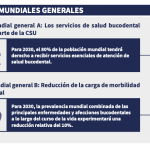
The World Health Organization (WHO) has published the Global Strategy and Action Plan on Oral Health 2023–2030. This document proposes actions to improve oral health globally, focusing on the promotion of healthy environments, strengthening health systems, disease prevention, research and international collaboration.
The Global Oral Health Strategy and Action Plan 2023-2030 arises in response to the growing burden of oral diseases. And, according to data published in the WHO’s 2022 Global Oral Health Status Report, oral diseases They affect approximately 3.5 billion people worldwideespecially in low- and middle-income countries.
The report also points out that oral diseases are the most widespread among all the conditions and diseases of humanity. In fact, the total estimated number of cases of oral diseases worldwide is approximately 1 billion more than the number of cases of the five major non-communicable diseases (NCDs) combined: mental disorders, cardiovascular diseases, diabetes, chronic respiratory diseases and cancers.
As the WHO points out in its Global Strategy and Action Plan on Oral Health 2023-2030, these oral diseases have a profound impact on people’s overall health and well-beinginterfering with basic functions such as eating, breathing and speaking, in addition to negatively affecting quality of life and productivity.
For this reason, the Dr. Tedros Adhanom GhebreyesusDirector General of the WHO, explains that “this action plan is a practical instrument to support Member States in the task of adapt global oral health policies to national contexts. It outlines a set of priority actions for those, the WHO secretariat, international partners, civil society organizations and the private sector adopt guidelines that bring them closer to the common commitment to achieve equitable access to oral health for all”.
Plan objectives
The purpose of the plan is to “ensure that all people, regardless of their location or socioeconomic status, have access to essential oral health services and can enjoy a life free of oral pain and discomfort”. For this, 6 strategic objectives are proposed:
Strategic objective 1: oral health
This objective focuses on “increasing political and resource commitment to oral health, strengthening leadership and creating beneficial partnerships within and outside the health sector, with the aim of integrating oral health into all public health policies and programs, reform the health and education systems, and establish national units dedicated to this area with trained professionals.” For this reason, they propose “the creation of sustainable alliances with communities, civil society and the private sector to mobilize resources and address the social and commercial determinants of oral health.”
Strategic objective 2: promotion of oral health and prevention of oral diseases
This objective aims to “reduce the social and commercial determinants and risk factors of oral diseases through effective and sustainable interventions. At a structural level, it seeks to establish public policies and community initiatives that promote equity in oral health. At a medium level, interventions are promoted in key settings such as schools and workplaces. At a concrete level, oral health education is crucial to developing personal and social capabilities.” As they point out in the document “prevention measures must be integrated with NCD prevention strategies and policies to reduce the consumption of tobacco, alcohol, unhealthy diets and free sugars.”
Strategic objective 3: health personnel
The next objective seeks to “develop innovative staffing models and expand competency-based training to increase available capabilities in oral health.” To carry it out, they indicate that “it is essential to have qualified health workers to provide essential services in this area. The reform of professional training must include competencies in community health, public health, leadership and research, fully integrating oral health services into primary care.”
Strategic objective 4: oral health care
The purpose of this goal is to “integrate essential oral health care into primary care and ensure financial protection and necessary supplies.” To develop this objective, they propose “increasing the access of the entire population to safe, effective and affordable oral health services as part of universal health coverage. The use of digital health technologies to improve the accessibility and effectiveness of oral health services is also explored.”
Strategic objective 5: oral health information systems
This objective seeks to “improve oral health surveillance and information systems to provide relevant and timely data to decision makers.” The measure they propose to achieve this is to “develop integrated information systems that guide planning and policy formulation, collecting data on oral health status, risk factors and available resources. The implementation of information systems must be supported by a monitoring framework and protect patient data.”
Strategic objective 6: oral health research agendas
The last of the stated objectives aims to “create and update research agendas specific to the context and needs in oral health, focusing on public health aspects.” As a measure, they propose “translating research results into practice through evidence-based clinical guidelines and supporting the development and evaluation of oral health policies.”
Scope, purpose and general goals
Following the six proposed objectives, a set of measures will be established evidence-based, adaptable to national and subnational contexts. The proposed measures must be adjusted and prioritized by each country, considering the available resources, the needs of the population and the socioeconomic and political context.
To monitor the implementation of the plan, Two overall global goals and nine targets corresponding to the strategic objectives have been defined, together with a set of core indicators. WHO will periodically publish these indicators, based on data provided by Member States. In addition, complementary indicators are suggested for broader monitoring at the national level, thus promoting the adoption of informed policies and decisions.


